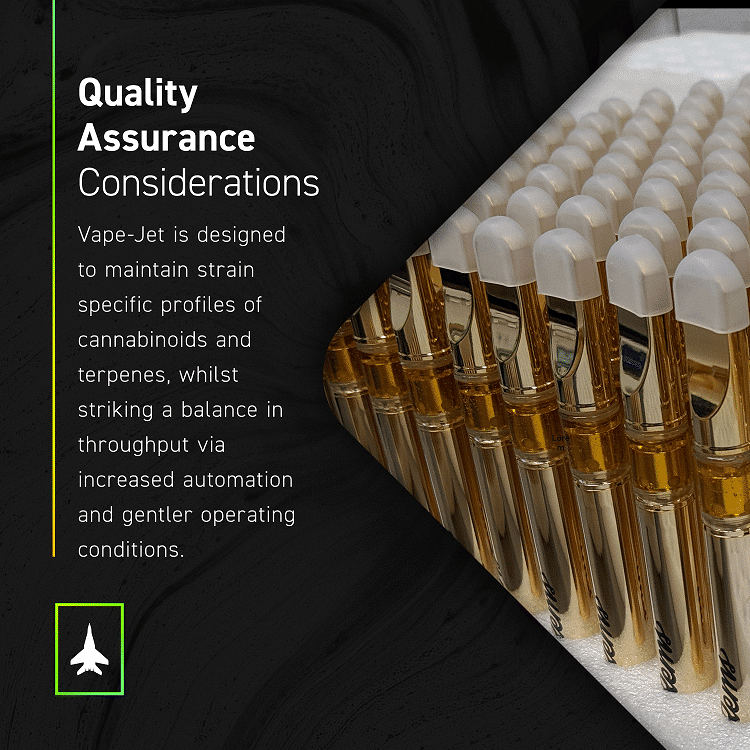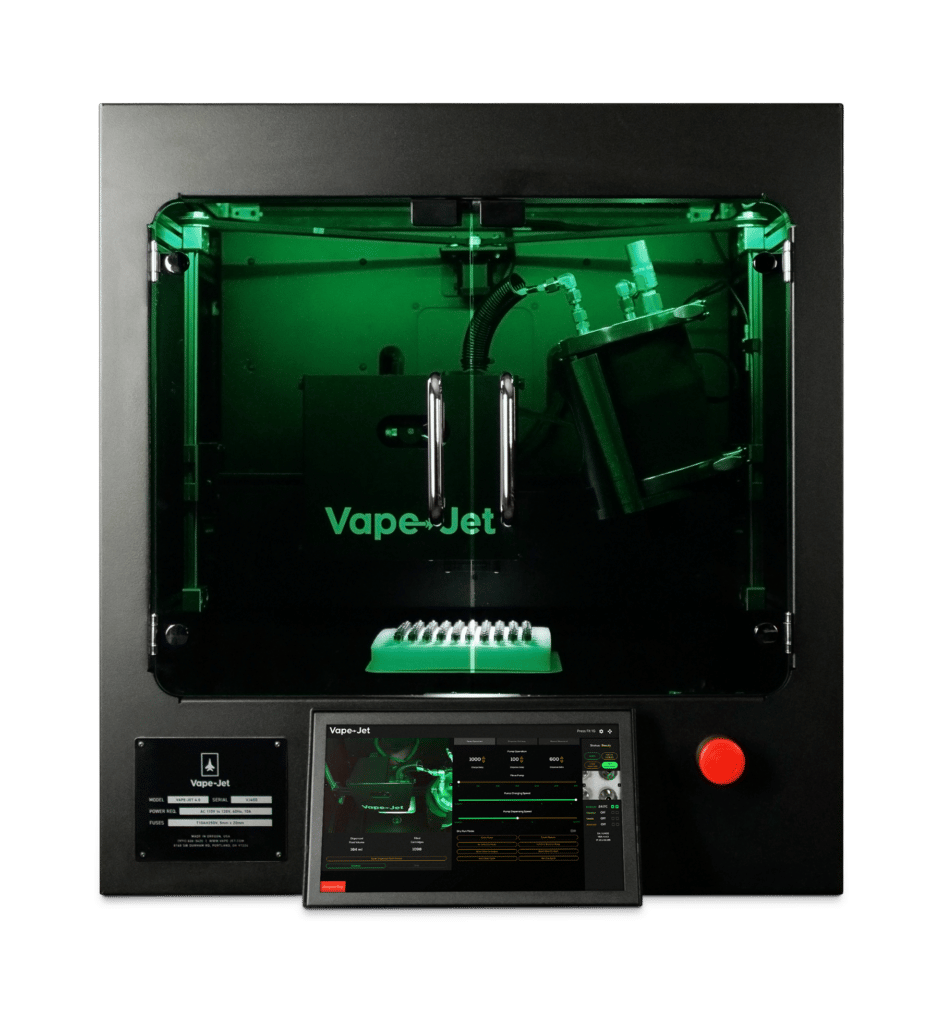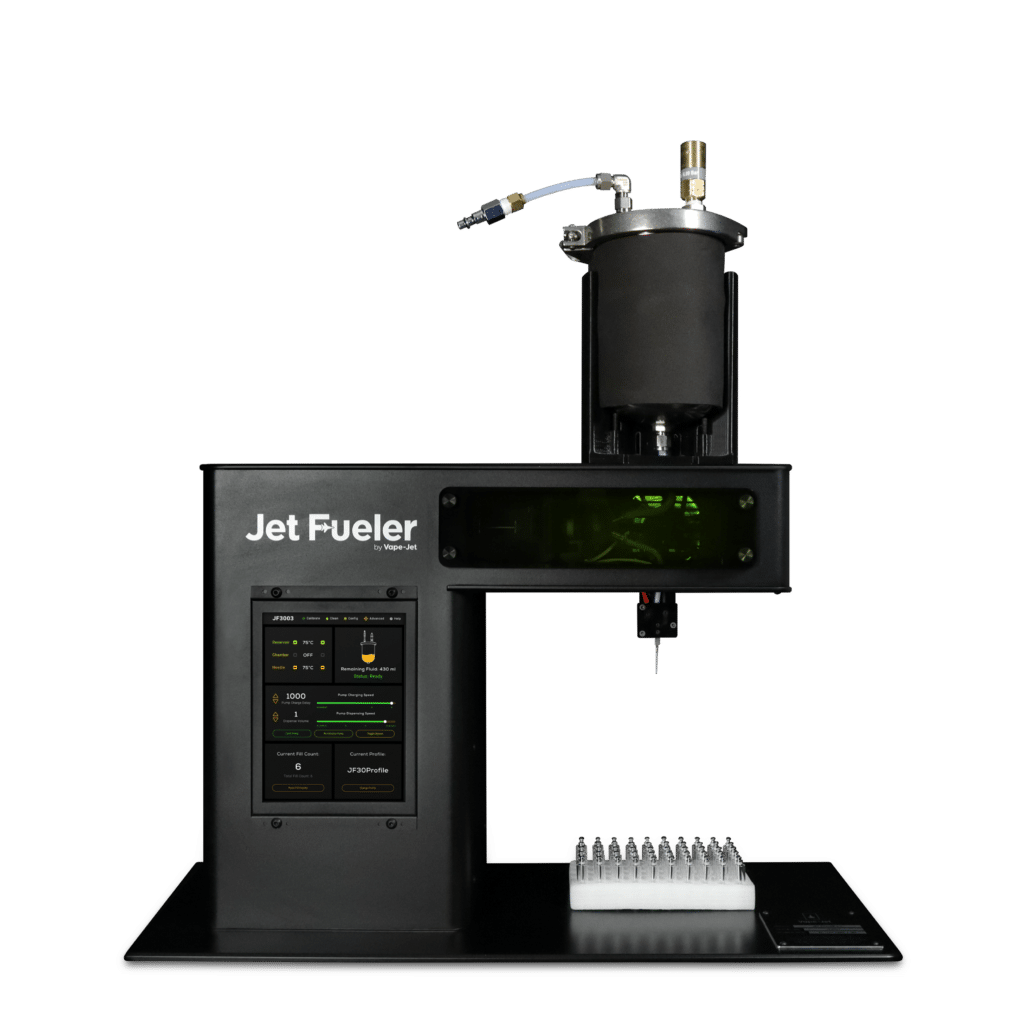The design and operating conditions of Vape-Jet 3.0 enable the reliable manufacture of high-quality vaporization cartridges which maintain the intended cannabinoid and terpene profiles until the point of consumption. No other automated filling solution has the degrees of freedom necessary to control dispensing accuracy whilst simultaneously preserving product integrity and quality.

Overview: Fluid Dynamics and Thermal Degradation
The problem of fluid dynamics is the primary obstacle to reliably filling a vaporization cartridge. The dynamics of cannabis derived fluids varies greatly from highly viscous to free-flowing, with every possibility in between depending primarily upon the concentration of cannabinoids (THC, CBD) relative to terpenes (linalool, myrcene, etc.). Fluid viscosity generally decreases with increasing temperature, and increases with decreasing temperature; i.e. warm fluids flow more easily than cool fluids.
The problem of thermal degradation is often an afterthought in the task of filling vaporization cartridges. Both cannabinoids and terpenes are susceptible to thermal degradation, with terpenes being especially vulnerable to heat in the presence of oxygen. McGraw, Hemingway, et al reported in a 1999 study of terpene thermal degradation that 23-37% of α-pinene is destroyed at temperatures between 90-120C, other terpenes exhibited degradation of as little as 7% or as much as 100% under the same conditions. Coffman and Gentner reported that THC degradation of 8-14% occurs at temperatures above 85C, with similar figures for CBD degradation; the result is a dramatically increased proportion of CBN, the oxidized product. By comparison, THC degradation at 65C resulted in only 3.4% loss, or 159% less degradation than 85C, or 300% less degradation than 105C.
Profile Preservation
The desire for ever increasing throughput has resulted in the adoption of extreme operating conditions by competing vaporization cartridge filling solutions. Competitors routinely make claims of filling 100 cartridges in as little as 2-5 minutes, which is completely achievable with operating temperatures in the neighborhood of 90C-120C. However, as has been illustrated, these temperatures will invariably result in thermal degradation of both cannabinoids and terpenes, resulting in a not-true-to-strain effect for the end user of vaporization cartridges filled in this manner. Not only is the profile different from the originating whole flower, the batch-to-batch and inter-batch variability will also be higher since these extreme temperatures create time-dependent changes in the overall profile. For example, the cartridges filled at Time-0 at 90C will be substantially different than the cartridges filled at the end of that batch.
Vape-Jet is designed to maintain strain specific profiles of cannabinoids and terpenes, whilst striking a balance in throughput via increased automation and gentler operating conditions. Vape-Jet is able to operate at 50C-70C due to the utilization of pressurized Modified Atmosphere Processing (MAP) techniques. With the assistance of pressurized nitrogen, mixed cannabinoids and terpenes are able to be accurately dispensed into vaporization cartridges with significantly reduced thermal degradation and oxidation products. The pressurized product line results in a modified fluid dynamic system, enabling reduced heating to create flow from reservoir to cartridge.
Quality Control and Assurance
The reduced operating temperature of Vape-Jet has the added manufacturing benefit of decreased cartridge leakage, since the product cools immediately upon filling, the atomizer doesn’t become over-saturated before the cap can be installed. Together with pre-fill inspection, Vape-Jet provides unrivaled reduction in waste and batchwise variability. Cartridges filled with Vape-Jet are more true to strain for the end user than any cartridge filled by a competing device. The filling accuracy of Vape-Jet, both in terms of quantity and quality, is unrivaled and assures that the customer receives exactly what was purchased, no more or less.
References:
G.W. McGraw, R.W. Hemingway, et al. United States Department of Agriculture Forest Service. Thermal Degradation of Terpenes: Camphene, Δ-Carene, Limonene, and α-Terpinene. Retrieved from: https://www.fs.usda.gov/treesearch/pubs/1366
C.B. Coffman, W.A. Gentner. United Nations Office on Drugs and Crime. Cannabis Sativa L.: Effect of Drying Time and Temperature on Cannabinoid Profile of Stored Leaf Tissue. Retrieved from: https://www.unodc.org/unodc/en/data-and-analysis/bulletin/bulletin_1974-01-01_1_page006.html













